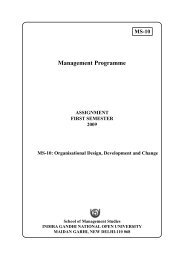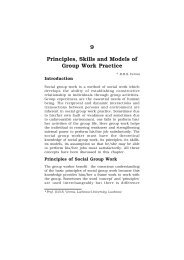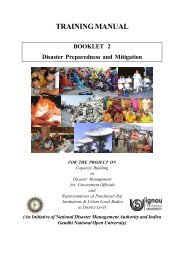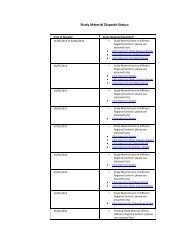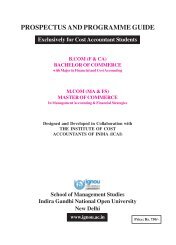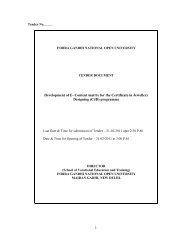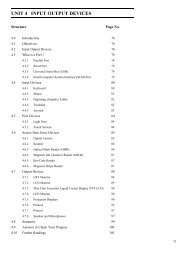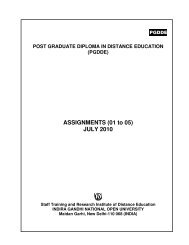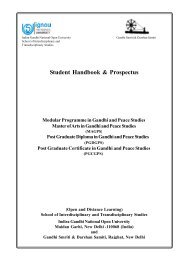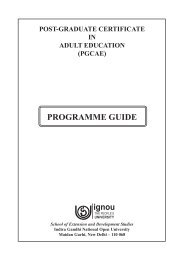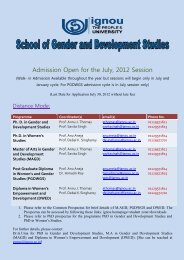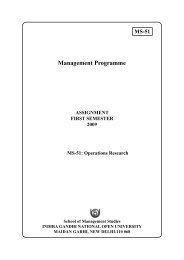PROSPECTUS AND PROGRAMME GUIDE - IGNOU
PROSPECTUS AND PROGRAMME GUIDE - IGNOU
PROSPECTUS AND PROGRAMME GUIDE - IGNOU
You also want an ePaper? Increase the reach of your titles
YUMPU automatically turns print PDFs into web optimized ePapers that Google loves.
7. Inter-departmental Communication<br />
Internal memos; office circulars; office orders; office notes; representation to chief executive and replies<br />
thereto; communication with regional/branch offices.<br />
8. Preparation of Press Releases.<br />
Objective:<br />
Course-6<br />
BCO-032: Economics and Statistics<br />
To provide basic and conceptual understanding of economic concepts, principles of economics and statistical<br />
tools to interpret and analyse various economic phenomena.<br />
Contents :<br />
1. Nature and Scope of Economics<br />
Part A: Economics (50 Marks)<br />
Definition, nature and scope of economics; micro and macroeconomics; positive and normative economics;<br />
working of economic systems with special reference to the capitalistic, socialistic and the mixed economies.<br />
2. Demand and Supply Analysis<br />
Utility analysis - total utility and marginal utility; law of diminishing marginal utility; law of equi-marginal<br />
utility; consumers’ equilibrium; law of demand; elasticity of demand; law of supply, elasticity of supply;<br />
demand and supply equilibrium.<br />
3. Production, Costs and Revenue Analysis<br />
Factors of production, meaning of production, laws of returns; returns to scale; cost concepts and cost<br />
curves; revenue concepts and revenue curves.<br />
4. Market Forms and Equilibrium of the Firm and Industry<br />
Market forms - meaning and characteristics; price and output determination and equilibrium of firm and<br />
industry under perfect competition, monopoly and monopolistic competition.<br />
5. Basic characteristics of Indian Economy<br />
Role of Agriculture, Industry & Service Sectors in the development of the Indian Economy; National<br />
income of India – Concept, significance, trends and measurement of national income.<br />
6. Select areas of Indian Economy<br />
Population – size and growth and impact of population on economic development; unemployment –nature,<br />
various measures to reduce it; foreign trade and India’s balance of payments. Five Year Plans and economic<br />
development; fiscal policy and national budget.<br />
7. Money and Banking<br />
Concept of money – its functions; Commercial Banks – role and functions; quantity theory of money;<br />
credit creation; Reserve Bank of India and its functions and monetary policy.<br />
8 Economic Reforms and Liberalisation<br />
Major economic reforms since 1991; Globalisation and its impact on Indian Economy; concept of WTOan<br />
overview.<br />
Part B: Statistics (50 Marks)<br />
9. Descriptive Statistics: Definition and functions of statistics, statistical techniques commonly used in<br />
business activities, law of statistics, limitations of statistics.<br />
10. Collection and Presentation of Statistical Data: Primary and secondary data; Classification and tabulation<br />
of data; frequency distribution of data; diagrams and graphs.<br />
A-27



